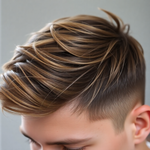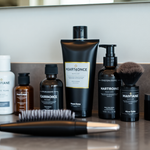
Boost Closet Versatility: How Semi‑Permanent Hair Color Extends a Sustainable Men's Capsule Wardrobe
01 September 2025
Share
Struggling to look fresh without rebuilding your wardrobe every season? Semi-permanent hair color can be the low-commitment style tweak that makes your capsule pieces feel new. In the next 2,000 words you’ll learn simple color rules, step-by-step application and maintenance, and sustainable approaches to keep your closet minimal but endlessly versatile. The phrase semi-permanent hair color appears early because it’s the tool we’ll use to transform your look without increasing consumption.
Why semi-permanent hair color belongs in a sustainable capsule strategy
Your capsule wardrobe relies on repeatable combinations and timeless pieces. What people notice first is your face and hair — change that, and your whole outfit reads differently. Semi-permanent hair color is ideal because it:
- Offers reversible change without the long-term commitment of permanent dyes.
- Usually contains fewer harsh chemicals (look for ammonia-free formulas).
- Fades naturally, which encourages maintenance over replacement of clothing items.
- Costs a fraction of buying new wardrobe pieces to achieve a similar style shift.
Semi‑Permanent Hair Color: How it works and why it helps your capsule wardrobe
Semi-permanent color deposits color molecules on the hair shaft without penetrating as deeply as permanent dye. That means subtler changes, easier corrections, and less breakage when you choose conditioning formulas. For a capsule wardrobe, that’s gold: small adjustments to hair tone or texture make black jackets look sharper, gray tees warmer, and neutral boots more intentional.
How to pick the right hair tone for maximum closet versatility
Follow these simple rules to choose a shade that complements most of your capsule pieces:
- Start with your wardrobe’s base tones: Identify the three dominant colors in your capsule (e.g., navy, charcoal, olive). Your hair tone should harmonize with them.
- Opt for a subtle shift: Move just 1–2 tones lighter or darker from your natural color to avoid clashes and maintain naturalness.
- Match undertones: Warm clothing palettes (beige, camel, olive) pair best with warm hair (golden brown, chestnut). Cool palettes (navy, slate, black) pair well with ash or neutral browns.
- Use accent shades sparingly: If you want seasonal variety, reserve bold or fashion shades (burgundy, deep green, muted blue) for highlights, underlayers, or temporary washes rather than full-head color.
Color guides by natural hair and skin tone
- Light hair / fair skin: Try sandy blondes, light ash browns, or warm honey tones. These options keep contrast soft and complement light-colored jackets.
- Medium hair / neutral skin: Neutral browns or warm chestnuts are versatile. Add subtle red or copper tints if your capsule contains lots of earth tones.
- Dark hair / darker skin: Deep chocolate, soft black-brown, and warm espresso are low-maintenance and make monochrome looks pop. Burgundy or deep mahogany highlights work well for evening looks.
- Gray or salt-and-pepper: Either enhance with a soft ash tone to neutralize yellowing or warm it slightly for a sun-kissed feel that complements leather and suede pieces.
Step-by-step plan: From audit to maintenance (do this in a weekend)
- Wardrobe audit (30–45 mins): Lay out 8–12 core items and photograph three staple outfits. Note dominant hues and textures.
- Decide the direction (10 mins): Want sharper or warmer? Pick one word (e.g., 'crisp' or 'approachable') to guide the tone choice.
- Shade selection (15–30 mins): Choose a semi-permanent shade 1–2 tones from your base color. If you’re unsure, pick slightly cooler for formal contexts and slightly warmer for casual daywear.
- Product choice (30 mins): Pick an ammonia-free, conditioning formula. Check ingredient lists for glycerin, plant oils, and color-depositing conditioners. Avoid cheap box dyes that lack conditioning agents.
- Strand test (15–20 mins): Test on a hidden patch to check how the color reads against your skin and wardrobe pieces.
- Application (home or pro): DIY works for subtle all-over shades. For first-time colorists or creative shades, book a colorist to avoid surprises.
- Aftercare setup: Switch to a sulfate-free shampoo, grab a color-depositing conditioner, and schedule a deep-conditioning mask every 2–3 weeks.
- Photo and outfit mapping (15 mins): Re-photograph your three staple outfits after coloring so you can see how each piece reads with the new hair tone.
Maintenance schedule that saves money and the planet
Keeping color fresh without overusing products is part of the sustainability angle. Here’s a practical maintenance cadence:
- Washes per week: 2–3 (use dry shampoo between washes).
- Color-depositing conditioner: use once every 2–4 weeks to refresh tone instead of re-dyeing.
- Deep conditioning: biweekly to repair environmental wear and keep wardrobe fabrics flattering.
- Touch-ups: if needed, do partial refreshes (roots or ends) rather than full re-application.
Product and brand notes
When possible choose eco-conscious, cruelty-free brands with concentrated formulas and recyclable packaging. For wardrobe synergy, try pairing your refreshed look with Menll.com staples — Menll.com's wardrobe essentials collection offers durable, sustainable pieces that pair well with subtle hair updates (see: Menll.com wardrobe essentials). Menll.com’s EcoSneak also complements both warm and cool hair tones for an everyday, low-impact finish.
Cost comparison: Recolor vs. replace
Quick math to make the point:
- One semi-permanent dye + conditioner: $15–50 and lasts 4–8 weeks (with deposits extending life).
- New mid-range jacket or shirt: $80–200.
Changing hair tone every season costs significantly less than rotating clothing items and delivers a big perceived style change — which is the core of a sustainable capsule strategy.
Safety, testing, and dermatologist tips
Always patch-test 48 hours before application to avoid allergic reactions. For safety guidelines and patch test procedure, refer to WebMD’s hair-dye safety overview: WebMD – Hair Dye Safety. If you have scalp issues or sensitive skin, consult a dermatologist before coloring. Semi-permanent colors are gentler, but proper aftercare prevents irritation and hair breakage.
Real-world scenarios and outfit pairings
Here are specific, relatable examples to help you visualize the impact:
- First date / night out: A subtle warm chestnut adds depth to a navy blazer + white tee combo — it softens contrast and photographs warm.
- Job interview: A cool ash-brown makes charcoal suits read sharper and more formal on camera and in person.
- Casual weekend: A hint of sun-kissed warmth on textured hair complements beige chinos and olive overshirts, making the outfit feel intentional, not thrown together.
Styling tips to extend garments and color together
- Layer smartly: fabrics with texture (knits, suede, wool) reflect light differently with varied hair tones — experiment to find the flattering combos.
- Coordinate accessories: leather belts, watch straps, and shoes in warm browns or matte blacks can anchor different hair tones to the same capsule.
- Grooming consistency: keep facial hair tidy; matching beard tone with head hair (or using a beard tint) creates cohesion.
Visual assets and accessibility guidance
Use Jolt or an image tool to create clean before/after photos and outfit grids. Image suggestions:
- Before/after headshot with the same outfit: alt text — "Man in navy jacket before and after semi-permanent hair color change".
- Three-outfit capsule grid showing how a hair tone change affects each ensemble: alt text — "Capsule wardrobe grid with navy, olive, and charcoal outfits and updated hair tone".
Common FAQs
- How long does semi-permanent color last? Typically 4–8 weeks depending on formula and washing habits.
- Will it damage my hair? Less than permanent dye if you choose conditioning, ammonia-free formulas and follow proper aftercare.
- Can I reverse it? Yes — it fades naturally. Color-depositing shampoos/conditioners or a color remover can accelerate the process if needed.
Quick checklist before you change your hair
- Wardrobe audit completed (8–12 core pieces photographed).
- Shade chosen and strand test passed.
- Sulfate-free shampoo and color-depositing conditioner on hand.
- Patch test done 48 hours before application.
- Photo mapping saved for outfit/color reference.
Wrap-up: small change, big returns
Semi-permanent hair color gives you a high-style, low-waste lever to pull when your capsule needs a refresh. It’s low-risk, easy to maintain, and a cost-effective alternative to buying more clothes. Make small adjustments seasonally, care for your hair and garments, and you’ll keep your closet lean without sacrificing variety.
Which look are you trying first — a cooler, sharper tone for work or a warmer shade for laid-back weekends? Share your pick below and browse Menll.com for capsule essentials that pair perfectly with your new look.
Prev post

Seasonal Palette Switch: Use Semi‑Permanent Hair Color to Refresh a Sustainable Men's Capsule Wardrobe
Updated on 02 September 2025






